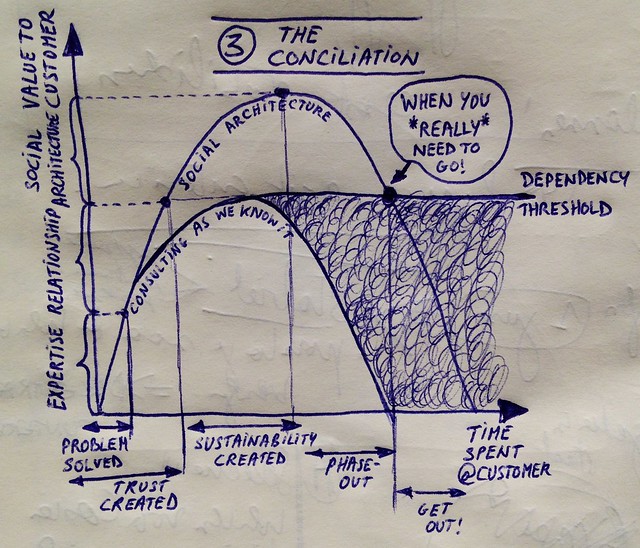As it turns out the development of a social architecture within an organization is the best way to cultivate ownership over benefits realization. And the magic happens during project installation.
The purpose of this post is to connect our findings on community development to the dots that we discovered in a previous blog-series on ‘When is it time to go?’. There are two reasons why this matters to me as a practitioner.
First, from a business ethics perspective, practitioners should focus on self-reliance of the client. This comes down to developing a community that is intertwined with the organization that is solid enough to sustain the change effort without external support. This also means that both, practitioner and client, need to be constantly aware of the seduction of the victim-rescuer dynamic.
Second, from a project management perspective, there is added value in connecting benefits realization to ownership and resource planning. In modern management speak we could refer to this blogpost as: finding the missing link between ‘social architecture’ and ‘benefits realization’.
Let’s examine those specific dots a little closer:
- There are three levels of permission we need to check before we can talk about a social architecture:
- Expertise: the legitimacy to be accepted as an expert
- Relationship management: the legitimacy to be respected
- Social Architecture: the legitimacy to co-create a future organization where roles and positions intertwine
- Engaging in the right conversation in order to determine when it is time to go, i.e.:
- Why do we engage in a customer relationship? (create awareness of dependency)
- Which role are we in? (‘Supplier – expert’ or ‘Capacity builder – social architect’?)
- Where exactly are we on the delivery curve (determine the take-off slot)
The conciliation of these insights can be drawn as follows:
Now, let’s add the layer of Benefits Realization on top, because – although it is forgotten in 99% of the cases – this is the reason why we engage in projects in the first place. As you recall, the difference between installation and realization is the following:
- Installation is defined as putting the intended change in place. Installation occurs when the change (e.g., hardware, software, training, new organizational structure) is deployed into the workplace.
- Realization means achieving the expected value of your change.
At this point we should realize that Installation can be done with any mindset; i.e.: ‘Consulting as we know it’ (the lower curve) and ‘Social Architecture’ (the higher curve). Benefits Realization on the other hand takes a longer period – and that’s just because it follows the logic of the return cycle of any investment.
In the big scheme of things project installation is the investment and the end of project installation should not be celebrated; because whenever something is celebrated the human mind thinks the intended goal is accomplished…
“Congratulations, you just spent a fortune making our organization go through an agonizing discomfort. Next, when the organization was in a stranglehold, you created a victim-rescuer dynamic. And now we are celebrating your heroic acts of stabilizing the organization. Well done!”
As an external consultant this is where customer engagements end and we head off to another customer because we need the adrenalin of yet another dependency. Or worse: we stay because the client has gotten addicted to the dynamic we just put in place.
What should happen instead is that during project installation the thresholds are defined and agreed upon for benefits realization. Based on that same drawing we can now enhance it with the specific point in time when benefits realization comes into place. Have a look at the below drawing:
In a recent conversation I had with a fellow consultant who works for one of the few consultancies worldwide that are serious about benefits realization, he underscored some insightful things:
Next to the project metrics that monitor project installation, you should install the smallest amount of metrics with the highest level of confidence for benefits realization. These metrics refer to four main levels that are tied together: people, process, customer and financial – and the point is to install this dashboard early on during installation.
When we continued our conversation it became clear that it is not only a matter of integrating benefits realization milestones and activities during project installation. This is necessary but not sufficient. What we need to do next is making sure that ownership is created over benefits realization. This can only be done when we build a social architecture around the installation effort. And this is where the magic happens: DURING INSTALLATION.
There is a part of relationship management that we devote on ‘installation humanity‘ such as handholding, hypercare and transition. But then there is an extra part we need to devote to ‘realization ownership‘, which is indicated in green on the graph. As my fellow consultant explained:
Integrating realization milestones into the installation plan is necessary but not sufficient. Next to that, you will need to identify and agree upon minimal acceptable realization levels on the lowest level of an organization. This is where operational people declare and commit to the effort they are willing to make in order to contribute to the realization of benefits.
And reaching that specific point – where you reach the deepest level of impact down to the shop-floor level – requires that you do the emotional labor of relationship management. Again, this is the green area on the graph. Else you will lack the legitimacy to even start a conversation on the minimal acceptable realization levels.
Without the seeding of the green area you can forget about sustaining the yellow area – certainly when your organization has a culture of celebrating project installation. In other words: social architecture is necessary in order for an organization to take ownership of benefits realization in the long run.


